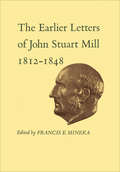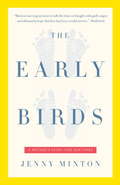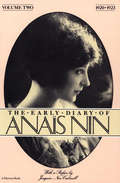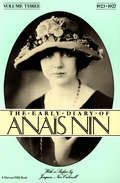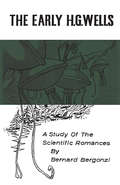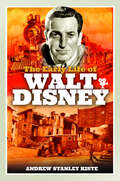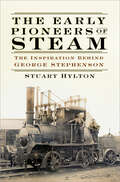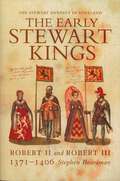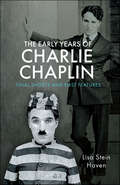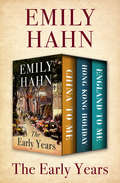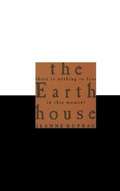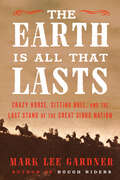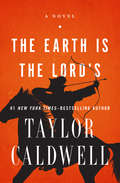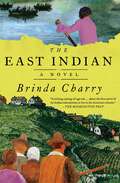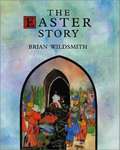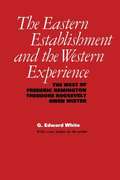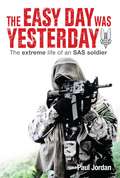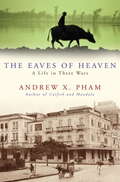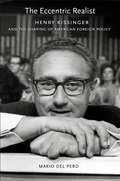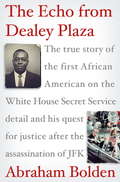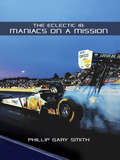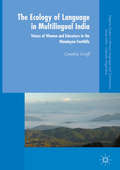- Table View
- List View
The Earlier Letters of John Stuart Mill 1812-1848: Volumes XII-XIII
by John Stuart Mill Francis MinekaThese volumes of Mill's letters have been awaited eagerly by all scholars in the field of nineteenth-century studies. They inaugurate most auspiciously the edition of the Collected Works of John Stuart Mill planned and directed by an editorial committee appointed from the Faculty of Arts and Science of the University of Toronto and from the University of Toronto Press. In this collection of 537 letters and excerpts of letters are included all the personal letters available. It contains 238 hitherto unpublished letters and 72 letters with previously unpublished passages. Letters previously published have been recollated whenever possible. All are meticulously edited and annotated.
The Early Birds: A Mother's Story for Our Times
by Jenny MintonIn the winter of 2002, Jenny Minton delivered twin boys. She was thirty-one weeks pregnant, and her boys, conceived through in vitro fertilization, were more than two months early. Both boys were placed on immediate life support, and for sixty-four days they hovered, critically ill, in the neonatal intensive care unit of a New York City hospital. The Early Birds is a record of their time there and the story of Minton's harrowing, triumphant quest to bring her sons home. With impeccable restraint, in sharp, unforgettable scenes, Minton takes readers into the heart of an experience that is both singular and with a significant increase in twin births over the last twenty years, and a commensurate rise in premature births increasingly common. She reflects with piercing candor on her persistent, often heartbreaking reckoning with her own guilt, and the inadequacy she feels for not having carried her boys to term. She examines how little she knew, and how little information doctors provided, as she entered the largely unregulated realm of assisted reproduction. She confronts her decision not to go back to work, and the overwhelming sensation that life has swept her away. She offers moving interrogations of science and fate, and the role of providence in conception. And she describes the glorious triumphs of ordinary life, even as she wrestles with the unanswerable questions that remain. A fiercely intelligent, closely observed, powerfully gripping narrative about conception and childbirth, and a poignant and provocative journey into motherhood in an age of modern medicine, told with precision and indelible grace.
The Early Diary of Anaïs Nin, 1920–1923: 1920–1923 (The Early Diaries of Anaïs Nin #2)
by Anaïs NinThe diarist&’s account of her life in the early 1920s explores &“the conflict she felt between artistic longings and her pre-ordained female fate&” (The Detroit News). Continuing the journey of self-education and self-discovery she began in Linotte, Anaïs Nin discloses a part of her life that had previously remained private. She discusses the period in which she met Hugo Guiler, the young man who later became her husband, and made the wrenching transition from the shelter of her family to the world of artists and models. She also reveals the struggle she faced between her expected role as a woman and her determination to be a writer—a negotiation that still poses difficulties for many of us almost a century after Nin wrote this diary. &“Through sheer nerve, confidence, and will, Nin made of the everyday something magical. This was a gift, indeed, and it&’s a fascinating process to witness.&” —The Christian Science Monitor With a preface by Joaquin Nin-Culmell
The Early Diary of Anaïs Nin, 1923–1927: 1923–1927 (The Early Diaries of Anaïs Nin #3)
by Anaïs NinA revealing look at the life of this &“extraordinary and unconventional writer&” during the mid-1920s (The New York Times Book Review). In this volume of her earlier series of personal diaries, Anaïs Nin tells how she exorcised the obsession that threatened her marriage—and nearly drove her to suicide. &“Through sheer nerve, confidence, and will, Nin made of the everyday something magical. This was a gift, indeed, and it&’s a fascinating process to witness.&” —The Christian Science Monitor With an editor&’s note by Rupert Pole and a preface by Joaquin Nin-Culmell
The Early H.G.Wells: A Study of the Scientific Romances
by Bernard BergonziThis is a sensitive study of Wells' imaginative development during his formative years. It comes at a time when interest in H.G. Wells' early writing is beginning to revive, owing, no doubt, to the current translation into reality of some aspects of science fiction.Mr. Bergonzi examines Wells' early fiction, from surviving student writings of the late eighties to 1901 when he published The First Men in the Moon, his last significant scientific romance, and Anticipations, his first systematic non-fictional treatise. The main emphasis of his study falls on the scientific romances of the nineties, which are examined in detail. In addition to literary analysis, relevant source material and reviews, which show how contemporaries received Wells' work, are noted.Wells' early attitude to science is shown to have been deeply ambivalent, as is apparent in his successive uses of the Frankenstein archetype. His intellectual attitudes tended towards scepticism and pessimism rather than to the 'utopian' optimism associated with his later career.These romances reflect in imaginative and non-discursive form some of the major preoccupations of late-Victorian England: the impact of Darwinism, of Socialism, and an increasing lack of national self-confidence. Mr. Bergonzi sees Wells as essentially a fin de siècle myth-maker, and he argues that it is this aspect of Wells' work which most requires attention if he is to be remembered in the future. Two early pieces by Wells, now unobtainable elsewhere, are given in an Appendix. One, The Chronic Argonauts, a fragment of a fantastic novel written at the age of 21, is the earliest draft of The Time Machine.
The Early Life of Walt Disney
by Andrew Stanley KisteThe Origins of Walt Disney tells the story of the famous artist and entertainer in a fresh way, placing him in the cultural narrative of twentieth century America and the world.Most biographies of Walt Disney portray him as a creative genius who revolutionized the entertainment industry during the first half of the twentieth century. While he did transform the medium of animation, quickly becoming a household name during his late thirties, many biographies tell the story of Walt Disney’s development in a historical vacuum, separate from the historical events happening around him. However, while Walt Disney was certainly a history-influencer, historical events happening in America and the world also shaped the entertainment pioneer he would become. As the twentieth century began, a new form of entertainment, “motion pictures,” would emerge, capturing the imagination of a young boy from Missouri. Over the next several years, Walt Disney would begin to hone his art skills, overcoming a number of hurdles including numerous relocations, a brutal paper route, a deployment to Europe in the days after World War One, numerous bankruptcies, and even homelessness. It was these adversities, along with the historical events that surrounded him, that would influence the man he would become. For the first time ever, The Early Life of Walt Disney tells some important stories that help to flesh out the Disney history. How instrumental was Elias Disney’s career as a carpenter in Chicago? Why did the Disneys really leave Chicago to move to Marceline, Missouri? What types of jobs did Walt perform in France in the days following World War One? How was Walt influenced by the budding industry of animation in America? In addition to answering these questions, The Origins of Walt Disney also includes a tour of the newly restored Walt Disney Birthplace, a new museum located in the childhood home of Walt Disney in Chicago, Illinois!
The Early Pioneers of Steam: The Inspiration Behind George Stephenson
by Stuart HyltonWe think of the Stephensons and Brunel as the fathers of the railways, and their Liverpool and Manchester and Great Western Railways as the prototypes of the modern systems. But who were the railways’ grandfathers and great-grandfathers? The rapid evolution of the railways after 1830 depended on the juggernauts of steam locomotion being able to draw upon centuries of experience in using and developing railways, and of harnessing the power of steam. Giants the Stephensons and others may have been, but they stood upon the foundations built by many other considerable – if lesser-known – talents. This is the story of those early pioneers of steam.
The Early Poetry of Robert Graves: The Goddess Beckons
by Kersnowski Frank L.Like many men of his generation, poet Robert Graves was indelibly marked by his experience of trench warfare in World War I. The horrific battles in which he fought and his guilt over surviving when so many perished left Graves shell-shocked and disoriented, desperately seeking a way to bridge the rupture between his conventional upbringing and the uncertainties of postwar British society. In this study of Graves's early poetry, Frank Kersnowski explores how his war neurosis opened a door into the unconscious for Graves and led him to reject the essential components of the Western idea of reality—reason and predictability. In particular, Kersnowski traces the emergence in Graves's early poems of a figure he later called "The White Goddess," a being at once terrifying and glorious, who sustains life and inspires poetry. Drawing on interviews with Graves's family, as well as unpublished correspondence and drafts of poems, Kersnowski argues that Graves actually experienced the White Goddess as a real being and that his life as a poet was driven by the purpose of celebrating and explaining this deity and her matriarchy.
The Early Stewart Kings: Robert II and Robert III 1371–1406 (The\stewart Dynasty In Scotland Ser.)
by Stephen BoardmanThe Stewart Dynasty in Scotland series aims to bring the rich political heritage of late medieval and early modern Scotland before as wide a reading public as possible, with specialist authors writing for the general reader as well as the student or academic. This volume is number one in the series and is also the first scholarly biography of the two kings who established medieval Scotland’s most famous and durable royal dynasty. Robert II, long regarded as a weak and ineffective king, pursued a determined political and propaganda campaign which largely overcame initial political opposition. Robert III was forced to engage in a long-term struggle with his brother Albany for control of the kingdom. Firmly based on contemporary documentary sources, Stephen Boardman's study examines the ways in which the unjustly poor reputations of both kings grew from later embellishments to contemporary political propaganda.
The Early Years of Charlie Chaplin: Final Shorts and First Features
by Lisa Stein HavenA thorough look into the early life and career of Charlie Chaplin. Charlie Chaplin’s career has been described, critiqued, and scrutinized. There are book-length studies on Chaplin’s music hall career, his career at Keystone Studios and the Mutual Studios. Somehow, his tenure with First National studios, however, has been largely neglected, even though it was during this several-year contractual time period that Chaplin built and occupied his own studio for the first time, that he attempted and succeeded in filming a comedy feature (The Kid) and that he helped to set up United Artists, an organization that protected the salaries and creative freedom of actors in Hollywood. This period in Chaplin’s story is especially interesting because such landmark moments are accompanied by Chaplin’s first marriage and divorce, the death of his first child, his friendship with French silent film comedian Max Linder, World War I and the role he would play in it, and the production and release of several unsuccessful films that marked Chaplin’s first creative blockage - one that threatened his future career. This book will discuss the transitional periods just before and after the First National contract, as well as the all-important period satisfying it. Archival evidence provides most of the support for the book’s assertions, from the Chaplin archive (property of Roy Export, digitized by Cineteca di Bologna, Italy), and the personal archives of other individuals or institutions discussed. Rare photos will illustrate the story.
The Early Years: China to Me, Hong Kong Holiday, and England to Me
by Emily HahnMemoirs of an exotic, unconventional life in Asia and Great Britain in the 1930s and 1940s, from a colorful, prolific New Yorker writer ahead of her time. China to Me: A proud feminist and fearless traveler, Emily Hahn set out for China in 1935 and stayed through the early years of the Second Sino-Japanese War, wandering, carousing, living, loving—and writing. During her travels from Nanjing to Shanghai, Chongqing, and Hong Kong, where she lived through the Japanese invasion in 1941, Hahn embarks upon an affair with lauded Chinese poet Shao Xunmei; gets a pet gibbon and names him Mr. Mills; establishes a close bond with the women who would become the subjects of her bestselling book The Soong Sisters; battles an acquired addiction to opium; and has a child with Charles Boxer, a married British intelligence officer. Deemed scandalous at the time of its publication in 1944, Hahn&’s now classic memoir remains remarkable for her insights into a tumultuous period and frankness about her personal exploits. &“The keen prose is suffused with an intellectual freedom and freshness of perspective that vivify the concerns of a long-gone world.&” —Publishers Weekly Hong Kong Holiday: The same day they attacked Pearl Harbor, the Japanese invaded the British colony of Hong Kong, which they would occupy until their surrender in 1945. Emily Hahn was living there with her newborn daughter. The baby&’s father, Charles Boxer, the local head of British army intelligence, was imprisoned in a POW camp. With sharp observations and incisive wit, Hahn gives a vivid picture of her time in the oppressed city—from daily life in the bazaars, beauty shops, restaurants, and opium dens to the crowded hospitals and internment camps—until she fled the city in 1943 with her daughter. England to Me: Following the end of the Second World War, Hahn married Charles Boxer—fortunately reports of his beheading by the Japanese had been greatly exaggerated—and they returned to his inherited estate in the English countryside. From Southampton to London, Hahn offers a fascinating portrait of a postwar country in flux, as well as her own struggles to adjust to a more sedate English country life after her harrowing but exciting years in the Far East.
The Earth House
by Jeanne DuprauTwo women in the midst of busy suburban lives, one a dental hygienist, the other, a technical writer, visit a Zen center "out of curiosity and some vague inclination to find something deeper than our everyday experience." As these Western women encounter Eastern spirituality, they begin to develop a new life plan--centered on building a house in the Sierras--and life begins a new plan for them. Soon, the course of nature and humanity will collide, converge, and compromise in two lives transformed by pain and patience. Jeanne DuPrau gives us a powerful lesson in listening, loving, and letting go.
The Earth Is All That Lasts: Crazy Horse, Sitting Bull, and the Last Stand of the Great Sioux Nation
by Mark Lee Gardner"Fast-paced and highly absorbing." —Wall Street JournalA magisterial new history of the fierce final chapter of the "Indian Wars," told through the lives of the two most legendary and consequential American Indian leaders, who led Sioux resistance and triumphed at the Battle of Little BighornTrue West magazine's "Best Nonfiction Book of the Year" Winner of the Colorado Book AwardCrazy Horse and Sitting Bull: Their names are iconic, their significance in American history undeniable. Together, these two Lakota chiefs, one a fabled warrior and the other a revered holy man, crushed George Armstrong Custer’s vaunted Seventh Cavalry. Yet their legendary victory at the Little Big Horn has overshadowed the rest of their rich and complex lives. Now, based on years of research and drawing on a wealth of previously ignored primary sources, award-winning author Mark Lee Gardner delivers the definitive chronicle, thrillingly told, of these extraordinary Indigenous leaders.Both Crazy Horse and Sitting Bull were born and grew to manhood on the High Plains of the American West, in an era when vast herds of buffalo covered the earth, and when their nomadic people could move freely, following the buffalo and lording their fighting prowess over rival Indian nations. But as idyllic as this life seemed to be, neither man had known a time without whites. Fur traders and government explorers were the first to penetrate Sioux lands, but they were soon followed by a flood of white intruders: Oregon-California Trail travelers, gold seekers, railroad men, settlers, town builders—and Bluecoats. The buffalo population plummeted, disease spread by the white man decimated villages, and conflicts with the interlopers increased.On June 25, 1876, in the valley of the Little Big Horn, Crazy Horse and Sitting Bull, and the warriors who were inspired to follow them, fought the last stand of the Sioux, a fierce and proud nation that had ruled the Great Plains for decades. It was their greatest victory, but it was also the beginning of the end for their treasured and sacred way of life. And in the years to come, both Crazy Horse and Sitting Bull, defiant to the end, would meet violent—and eerily similar—fates.An essential new addition to the canon of Indigenous American history and literature of the West, The Earth Is All That Lasts is a grand saga, both triumphant and tragic, of two fascinating and heroic leaders struggling to maintain the freedom of their people against impossible odds.A Denver Post BestsellerA Spur Award Finalist, Best Western Historical NonfictionWinner of the John M. Carroll Literary Award
The Earth Is the Lord's: A Novel
by Taylor CaldwellFrom a #1 New York Times–bestselling author: A “magnificent” epic based on the early life of Genghis Khan (New York Herald Tribune). This sweeping saga captures life in the Far East during the Middle Ages and dramatizes the events that transformed a Mongol tribesman named Temujin into the man who would conquer Asia and be known to the world for centuries to come as Genghis Khan. Raised by an indomitable woman and educated by his outcast uncle, Temujin becomes a fearsome warrior who inspires loyalty in his friends and hatred in his enemies. But he is also blessed with a keen intelligence and the charisma of a natural born leader. In an era marked by treachery and savage violence, these gifts lead Temujin to a relentless pursuit of power. From the Gobi Desert to Samarkand, Taylor Caldwell transports readers to a distant world and shines a brilliant light on one of history’s most enigmatic figures. On her “huge historical canvas . . . blood spurts from the knife; beads of sweat stand out on straining flesh; lusts are consummated and revenges achieved” (New York Herald Tribune).
The Easdale Doctor: The Life and Times of Patrick H. Gillies
by Mary WithallAn inspiring biography of a Victorian-era physician who gave up the promise of fortune and glory to serve his small community on a Scottish island. When Patrick Gillies graduated from the University of Edinburgh&’s distinguished school of medicine with honors in 1890, a high-profile career as a surgeon lay ahead of him. Any city across the world would have welcomed him, and his university mentors, including the famous Joseph Lister, urged him to take up one of these opportunities. But Gillies defied them all and returned to his hometown of Easdale, determined to continue the work his father had begun as a physician to the parishioners of Scotland&’s Slate Islands. Over the next forty years, Patrick Gillies worked tirelessly to sustain and improve the community. While working as a General Practitioner, he involved himself in the needs of Easdale, fighting the closure of the local school as a member of the school board, and applying his expertise and determination to public health issues, working to build an isolation hospital and provide better medical care for children. Eventually, he would serve his country as well, in Army service in two wars. This biography is a portrait of a quiet hero, a tale of a dedicated doctor who stayed in a small town—and made a big difference.
The East Indian: A Novel
by Brinda CharryInspired by a historical figure, an exhilarating debut novel about the first native of the Indian subcontinent to arrive in Colonial America—for readers of Esi Edugyan and Yaa Gyasi.Meet Tony: insatiably curious, deeply compassionate, with a unique perspective on every scene he encounters. Kidnapped and transported to the New World after traveling from the British East India Company&’s outpost on the Coromandel Coast to the teeming streets of London, young Tony finds himself in Jamestown, Virginia, where he and his fellow indentured servants—boys like himself, men from Africa, a mad woman from London—must work the tobacco plantations. Orphaned and afraid, Tony initially longs for home. But as he adjusts to his new environment, finding companionship and even love, he can envision a life for himself after servitude. His dream: to become a medicine man, or a physician&’s assistant, an expert on roots and herbs, a dispenser of healing compounds. Like the play that captivates him—Shakespeare&’s A Midsummer Night&’s Dream—Tony&’s life is rich with oddities and hijinks, humor and tragedy. Set during the early days of English colonization in Jamestown, before servitude calcified into racialized slavery, The East Indian gives authentic voice to an otherwise unknown historic figure and brings the world he would have encountered to vivid life. In this coming-of-age tale, narrated by a most memorable literary rascal, Charry conjures a young character sure to be beloved by readers for years to come.
The Easter Story
by Brian WildsmithOnce, a long time ago, a little donkey was brought to Jesus. The little donkey had never been ridden before, but Jesus spoke gently to him, and soon he stopped being afraid. Jesus climbed onto the donkey's back, and they set off for Jerusalem . . . In clear, reverent language, award-winning author/illustrator Brian Wildsmith creates this companion book to his earlier A Christmas Story. With an enchantingly simple perspective that will engage even the very youngest child, Wildsmith offers a splendid new version of the greatest story ever told.
The Eastern Establishment and the Western Experience
by G. Edward WhiteFirst published in 1968, The Eastern Establishment and the Western Experience has become a classic in the field of American studies. G. Edward White traces the origins of "the West of the imagination" to the adolescent experiences of Frederic Remington, Theodore Roosevelt, and Owen Wister-three Easterners from upper-class backgrounds who went West in the 1880s in search of an alternative way of life. Each of the three men came to identify with a somewhat idealized "Wild West" that embodied the virtues of individualism, self-reliance, and rugged masculinity. When they returned East, they popularized this image of the West through art, literature, politics, and even their public personae. Moreover, these Western virtues soon became and have remained American virtues-a patriotic ideal that links Easterners with Westerners. With a multidisciplinary blend of history, biography, sociology, psychology, and literary criticism, The Eastern Establishment and the Western Experience will appeal to a wide audience. The author has written a new preface, offering additional perspectives on the mythology of the West and its effect on the American character.
The Easy Cannabis Cookbook: 60+ Medical Marijuana Recipes for Sweet and Savory Edibles
by Cheri SicardThe definitive guide to making easy, everyday ediblesGo beyond just cookies and brownies as you learn how to serve up delicious edibles perfect for every meal with this comprehensive exploration of cooking with cannabis.Written by Cheri Sicard—nicknamed the "Martha Stewart of weed" by The Daily Beast—this cannabis cookbook provides you with absolutely everything you need to redefine stoner eats. Whether it's Ganja Gazpacho, Barbecue Chicken, or Deviled Eggs, these simple and straightforward recipes make it a breeze to bring unique, properly dosed edibles to the table.This must-have marijuana cookbook includes:Cannabis 101—Discover a crash course on the history of marijuana and all the benefits it provides.Dosing guides—Find out how to measure potency and make sure your infusions meet their mark.Cooking fundamentals—Learn fundamental cooking skills, what equipment you need, and more.60 Tasty recipes—Go beyond cookies and brownies with recipes for breakfasts, lunches, dinners, and more.Get baked, roasted, and grilled cannabis-infused treats for every meal thanks to The Easy Cannabis Cookbook.
The Easy Day Was Yesterday: The Extreme Life of an SAS Soldier (Big Sky Publishing Ser.)
by Paul JordanFrom his cage in a putrid, overcrowded Indian gaol, Paul Jordan reflects on a life lived on the edge and curses the miscalculation that robbed him of his freedom. His childhood, marred by the loss of his father and brother, produce a young man hell bent on being the best of the best - an ambition he achieves by being selected to join the elite SAS. He survives the gut-wrenching training regime, deployment to the jungles of Asia and the horrors of genocide in Rwanda before leaving the army to embark on a career as a security adviser. His new life sees him pursuing criminals and gun-toting bandits in Papua New Guinea and the Solomons, protecting CNN newsmen as the US 7th Cavalry storms into Baghdad with the outbreak of the Iraq War, and facing death on a massive scale as he accompanies reporters into the devastated Indonesian town of Banda Aceh, flattened by the Boxing Day tsunami. During his 24 days in an Indian gaol, Paul Jordan discovers that friendship and human dignity somehow survive the filth and deprivation. This is a personal account of a tough, hardened fighter who suddenly finds himself totally dependent on others for his every need. The Easy Day was Yesterday is fast paced, brutally honest and raw, but laced with dark humour. The core of Paul Jordan's eventful life, however, is the strength of his bonds with family and friends and the ability of the human spirit to survive even the direst adversity.
The Eaves of Heaven
by Andrew X. PhamOne of the Ten Best Books of the Year, Washington Post Book World One of the Los Angeles Times’ Favorite Books of the Year One of the Top Ten National Books of 2008, Portland Oregonian A 2009 Honor Book of the Asian/Pacific American Librarians Association “Few books have combined the historical scope and the literary skill to give the foreign reader a sense of events from a Vietnamese perspective. . . . Now we can add Andrew Pham’s Eaves of Heaven to this list of indispensable books. ” —New York Times Book Review “Searing . . . vivid–and harrowing . . . Here is war and life through the eyes of a Vietnamese everyman. ” —Seattle Times Once wealthy landowners, Thong Van Pham’s family was shattered by the tumultuous events of the twentieth century: the French occupation of Indochina, the Japanese invasion during World War II, and the Vietnam War. Told in dazzling chapters that alternate between events in the past and those closer to the present,The Eaves of Heavenbrilliantly re-creates the trials of everyday life in Vietnam as endured by one man, from the fall of Hanoi and the collapse of French colonialism to the frenzied evacuation of Saigon. Pham offers a rare portal into a lost world as he chronicles Thong Van Pham’s heartbreaks, triumphs, and bizarre reversals of fortune, whether as a South Vietnamese soldier pinned down by enemy fire, a prisoner of the North Vietnamese under brutal interrogation, or a refugee desperately trying to escape Vietnam after the last American helicopter has abandoned Saigon. This is the story of a man caught in the maelstrom of twentieth-century politics, a gripping memoir told with the urgency of a wartime dispatch by a writer of surpassing talent.
The Eccentric Realist: Henry Kissinger and the Shaping of American Foreign Policy
by Mario Del PeroDuring the 2008 election season, the Democratic and Republican presidential candidates both aspired to be understood as foreign policy "realists" in the mold of Henry Kissinger. Kissinger, who is distrusted on the neoconservative right for his skepticism about American exceptionalism and on the liberal left for his amoral, realpolitik approach, once again stood as the sage of foreign relations and the wise man who rises above partisan politics. In The Eccentric Realist, Mario Del Pero questions this depiction of Kissinger. Lauded as the foreign policy realist par excellence, Kissinger, as Del Pero shows, has been far more ideological and inconsistent in his policy formulations than is commonly realized. Del Pero considers the rise and fall of Kissinger's foreign policy doctrine over the course of the 1970s-beginning with his role as National Security Advisor to Nixon and ending with the collapse of détente with the Soviet Union after Kissinger left the scene as Ford's outgoing Secretary of State. Del Pero shows that realism then (not unlike realism now) was as much a response to domestic politics as it was a cold, hard assessment of the facts of international relations. In the early 1970s, Americans were weary of ideological forays abroad; Kissinger provided them with a doctrine that translated that political weariness into foreign policy. Del Pero argues that Kissinger was keenly aware that realism could win elections and generate consensus. Moreover, over the course of the 1970s it became clear that realism, as practiced by Kissinger, was as rigid as the neoconservativism that came to replace it. In the end, the failure of the détente forged by the realists was not the defeat of cool reason at the hands of ideologically motivated and politically savvy neoconservatives. Rather, the force of American exceptionalism, the touchstone of the neocons, overcame Kissinger's political skills and ideological commitments. The fate of realism in the 1970s raises interesting questions regarding its prospects in the early years of the twenty-first century.
The Echo from Dealey Plaza
by Abraham BoldenA gripping and unforgettable true story of bravery and patriotism in the face of bitter hatred. Abraham Bolden was a young African American Secret Service agent in Chicago when he was asked by John F. Kennedy himself to join the White House Secret Service detail. For Bolden, it was a dream come true-and an encouraging sign of the charismatic president's vision for a new America. But the dream quickly turned sour. Bolden found himself regularly subjected to open hostility and blatant racism, and he was appalled by the White House team's irresponsible approach to security. In the wake of JFK's assassination, Bolden sought to expose the agency's negligence, only to find himself the victim of a sinister conspiracy. The Echo from Dealey Plazais the story of the terrible price paid by one man for his commitment to truth and justice.
The Eclectic 18: turbo articles, riveting reviews, inspiring life insights from unique books, movies, broadcasts, and race events critiqued in Radioactive Drag Racing News
by Phillip Gary SmithWhat’s it like to be a maniac on a mission? From the worlds of performance engineering, product development, drag racing, auto racing and human creativity, go beyond with THE ECLECTIC 18. Learn tipping points key to the success of The Justice Brothers oil empire uncovered only here. Realize lessons from Funny Car NHRA pioneer John Force’s rise to racing supremacy and how his success - and failures - may improve your life. Discover the “Top Ten Tommy Teachings,” shocking ways to survive absolute terminal cancer from one driven competitor. Absorb how a car known as Big Noise II dominated a man’s life and a tragedy. What about “My First Car” of yours; how does it stack up against Hugh Hefner’s, Steve McQueen’s, and many others you will know? Just try to be as big and creative in your thinking as “TV Tommy Ivo, Drag Racing’s Master Showman.” Take to heart a real maniac on a mission: “Mickey Thompson, the Fast Life and Tragic Death of a Racing Legend.” Use these readings for their lessons in life, then apply them. Joyfully “Dance the Western Swing,” “Light the Dark,” plus recognize what happens when one doubles down in Vegas with nitro chips. Understand the spectacle resulting “When 10000 Horsepower Goes Wrong.” With THE ECLECTIC 18 you, too, may just be one of “The New Kids on the Winner’s Block” of life. Find deeper meanings and helpful insights on striving to succeed and becoming relevant that also entertains. “THE ECLECTIC 18 traded the safety of emotional equilibrium for their compulsion to unabashedly collide with life’s vicissitudes with unrelenting verve.” Jeff Kildahl, Ph.D., Creator and President, The Wholistic Edge®
The Ecology of Language in Multilingual India: Voices of Women and Educators in the Himalayan Foothills (Palgrave Studies in Minority Languages and Communities)
by Cynthia GroffThis book explores the linguistic ecology of the Kumaun region of Uttarakhand, India through the experiences and discourses of minority youth and their educators. Providing in-depth examples of Indian multilingualism, this volume analyses how each language is valued in its own context; how national-level policies are appropriated and contested in local discourses; and how language and culture influence educational opportunities and identity negotiation for Kumauni young women. In doing so, the author examines how students and educators navigate a multilingual society with similarly diverse classroom practices. She simultaneously critiques the language and education system in modern India and highlights alternative perspectives on empowerment through the lens of a unique Gandhian educational context. This volume allows Kumauni women and their educators to take centre stage, and provides a thoughtful and nuanced insight into their minority language environment. This unique book is sure to appeal to students and scholars of multilingualism, sociolinguistics, language policy and minority languages.
